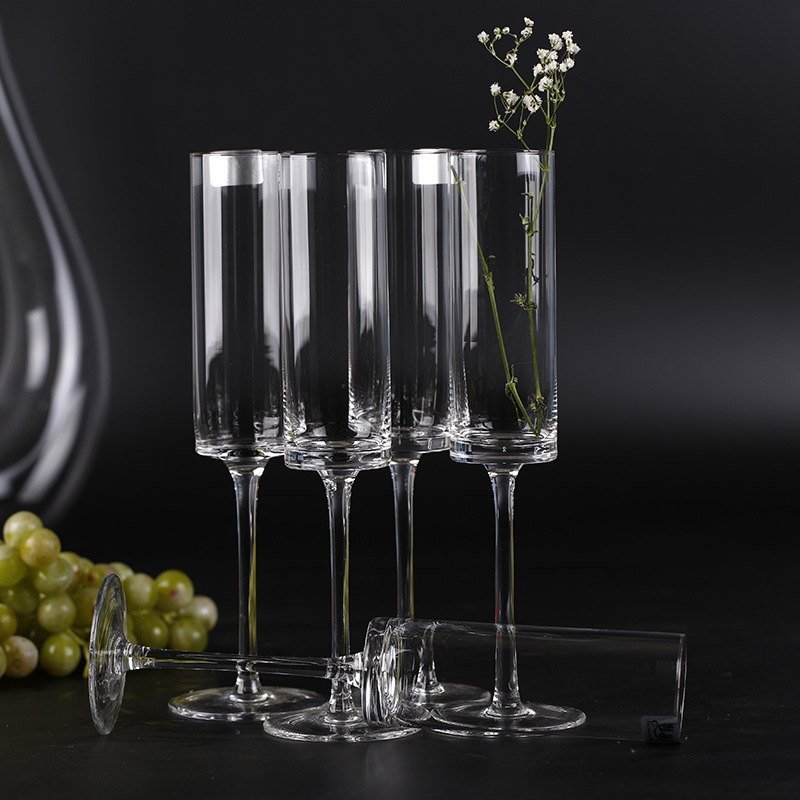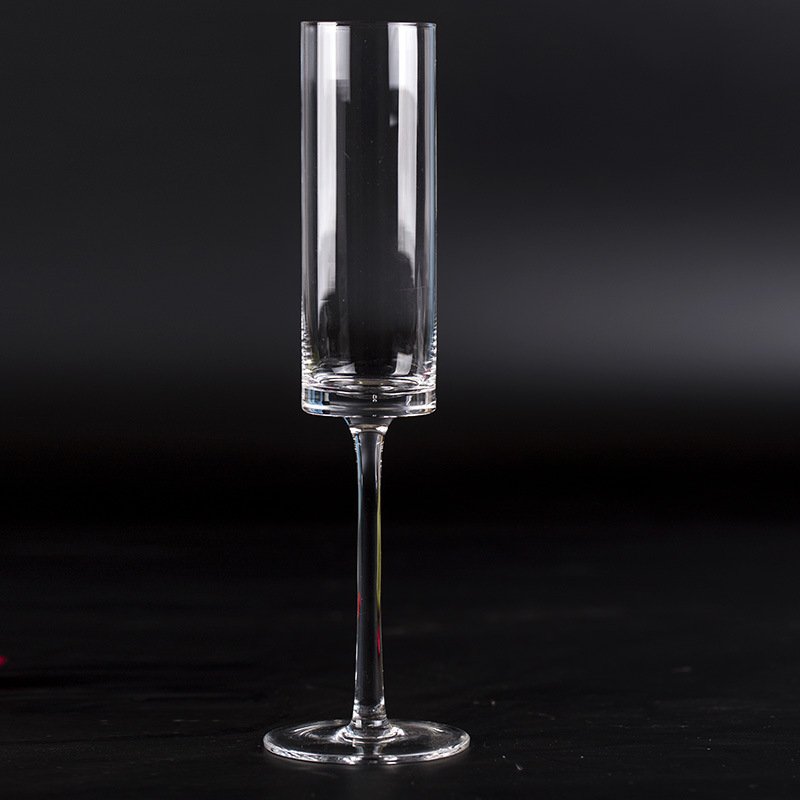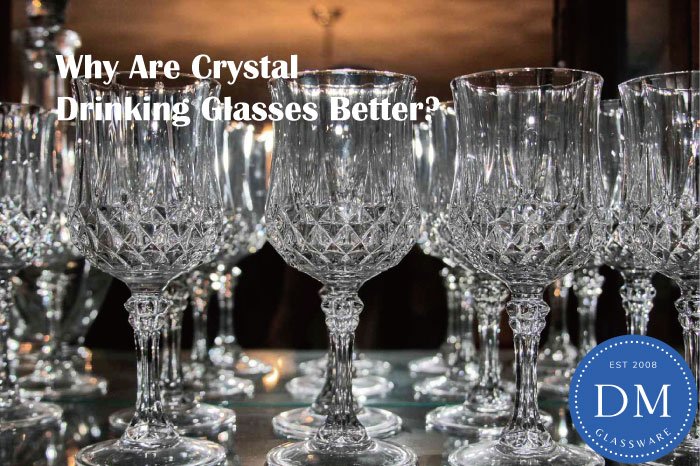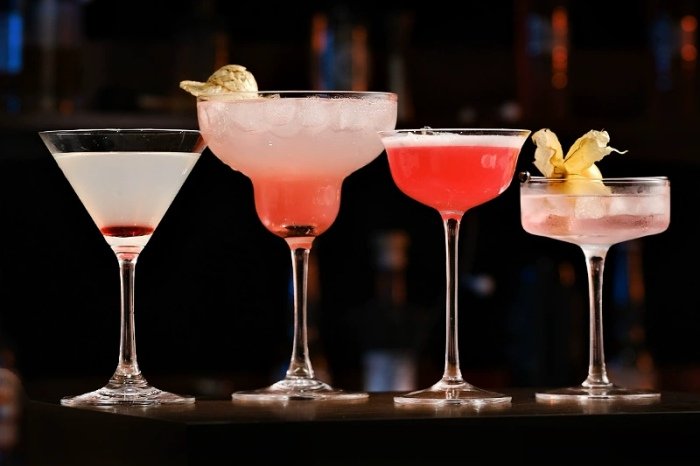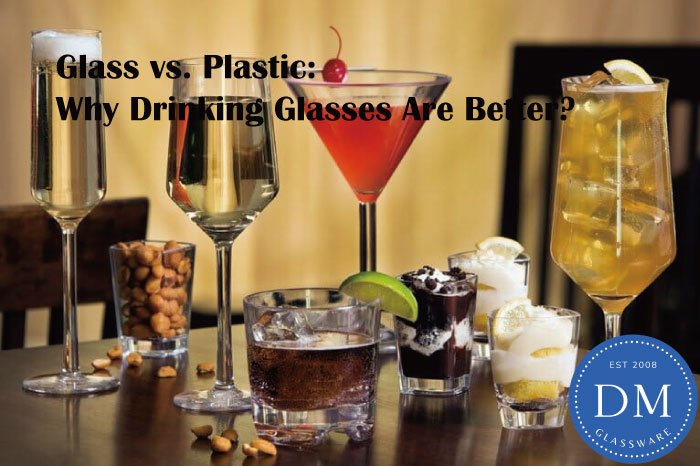
Comprehensive Guide to Champagne Glass Types: From Traditional to Custom
Introduction
Champagne, the celebratory beverage of choice for special occasions, requires appropriate glassware to fully showcase its unique bubbles and flavors. Selecting the right champagne glass is not merely an aesthetic decision—it significantly impacts bubble retention, aroma release, and the overall drinking experience.
This comprehensive guide explores the three main types of champagne glasses—Coupe, Flute, and Tulip—detailing their characteristics, history, proper usage, and how DM Glassware’s customization services can add personalized elements to your special occasions.
The Importance of Champagne Glassware
There are two primary reasons for choosing appropriate champagne glassware:
1.Sensory Experience: Properly shaped glasses preserve champagne’s effervescence, extending the duration of its mouthfeel, while directing aromas toward the nose, allowing you to better anticipate and enjoy the champagne’s flavors.
2.Psychological Impact: Drinking champagne from more elegant glassware subtly influences our perception of taste, enhancing the overall experience.
The Three Main Types of Champagne Glasses
1. Coupe Champagne Glass
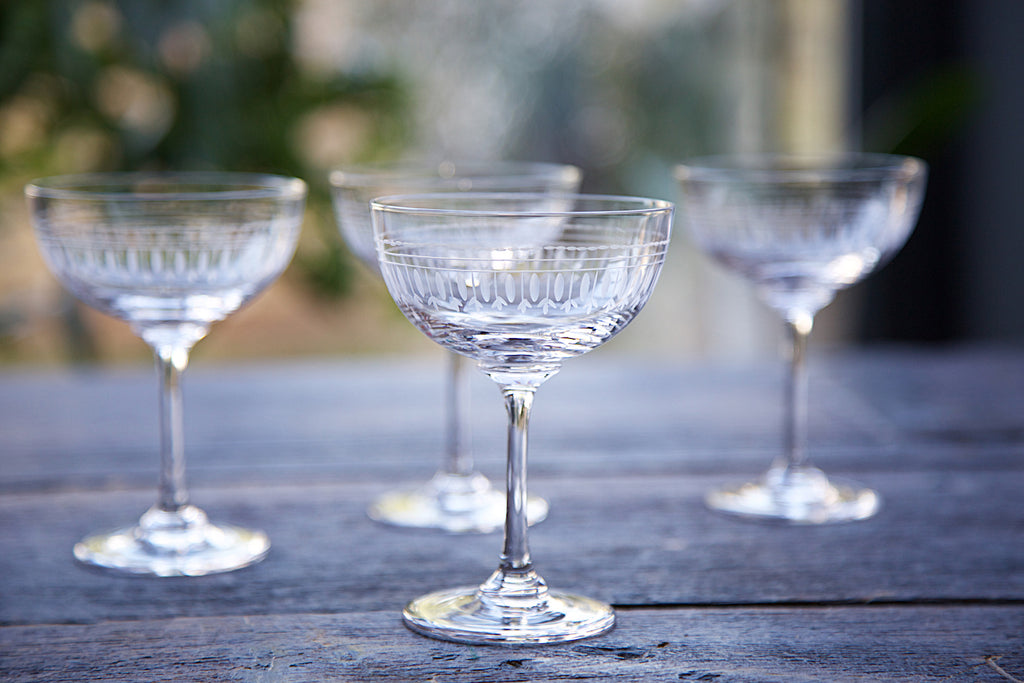
History and Design
The coupe, also known as the champagne saucer, was the original glassware specifically designed for serving champagne. Popularized in England in the early 1800s, it is one of the oldest styles of champagne glassware. This glass features a broad, shallow bowl with a short, elegant stem. A persistent rumor suggests that the coupe’s iconic round shape was modeled after the breast of 18th-century French Queen Marie Antoinette, though historians generally dismiss this as myth.
Characteristics
•Broad, shallow bowl
•Short, elegant stem
•Wide opening
•Vintage, classic aesthetic
•Typically holds more champagne per glass than other designs
Effect on Champagne
The coupe’s wide, open design creates a theatrical drinking experience where bubbles visibly dance across the surface. However, this same design causes carbonation to dissipate more quickly than in other glass types. The broad surface area allows more oxygen to interact with the champagne, which can help develop complex flavors and aromas over time, though at the expense of effervescence.
Proper Holding Technique
To maintain optimal temperature when drinking from a coupe, hold the glass either at the rim or by pinching the top of the stem. This prevents the champagne from warming too quickly from the heat of your hand.
Best Uses
•Creating eye-catching champagne towers
•Serving sparkling cocktails
•Adding a luxurious, theatrical element to celebrations
•Perfect for vintage-themed events and gatherings
2. Flute Champagne Glass
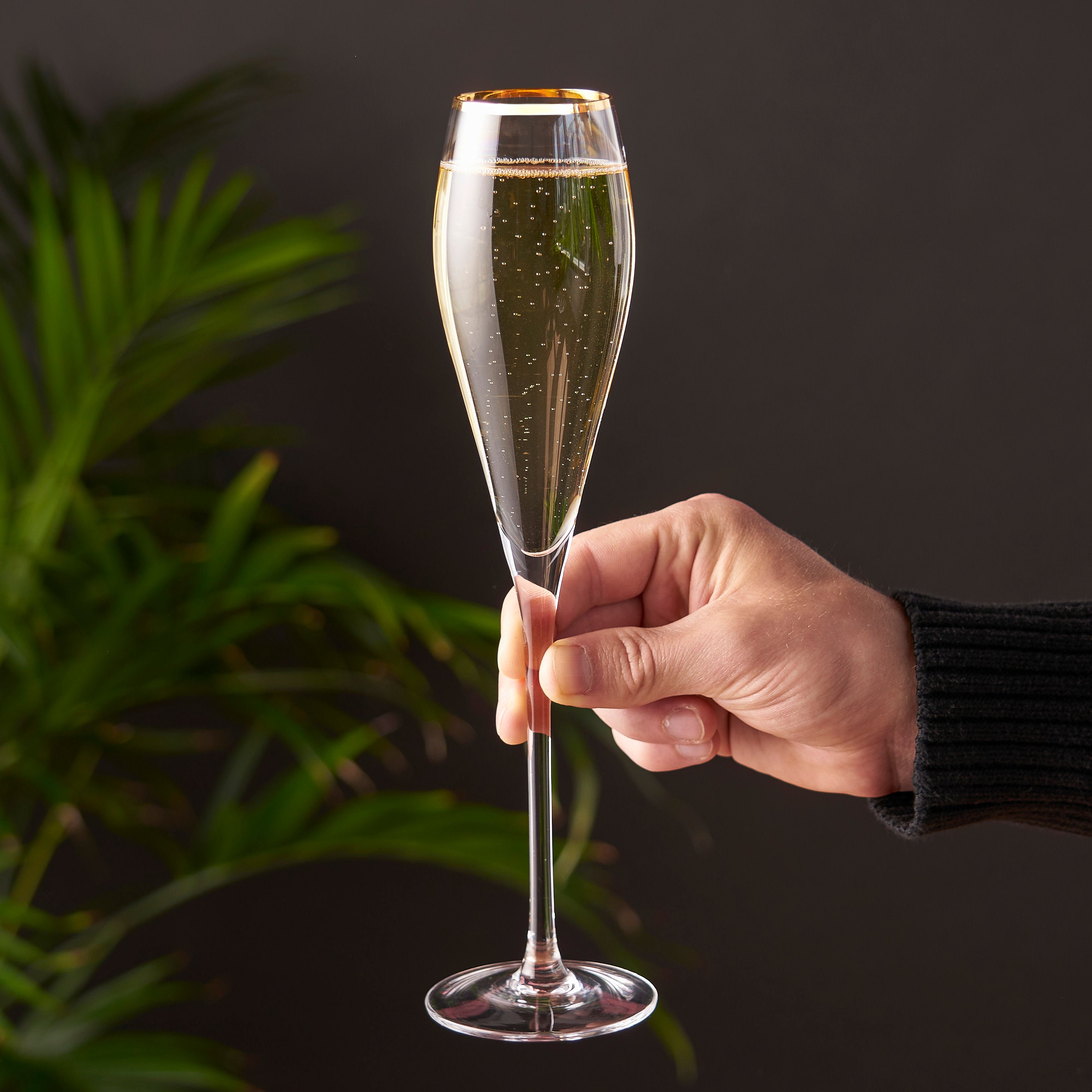
History and Design
By the 1920s, traditional coupes had fallen out of favor and were replaced by slimmer champagne flutes. The flute’s signature tall and narrow shape was designed to better preserve the wine’s flavor and carbonation.
Characteristics
•Tall, slender design
•Narrow bowl and opening
•Long stem
•Central indent at the bottom (nucleation point)
Variations
The flute category includes several design variations:
1.Classic Champagne Flute: Features a long, tapered conical shape that helps retain effervescence and concentrates bubbles in the center of the glass.
2.Trumpet Champagne Flute: Curves outward at the opening, creating a trumpet shape that concentrates bubbles at the rim and preserves the fizzy texture.
3.Square Champagne Flute: Features a squared-off design without the classic tapered opening, creating a more even distribution of bubbles that fizz more quickly.
4.Stemless Champagne Flute: A modern twist on the classic flute that retains the conical shape but removes the stem, resulting in the wine warming more quickly when held.
Effect on Champagne
The flute’s narrow design advantageously preserves the flavor and carbonation of the wine. The central indent at the bottom of the glass acts as a congregating point for bubbles and helps them float smoothly to the top, creating that signature stream of bubbles many associate with champagne. The narrow opening also concentrates aromas, though some experts argue it can restrict the full development of complex bouquets.
Proper Holding Technique
For stemmed flutes, hold the glass by pinching the top of the stem between your thumb and forefinger to prevent warming the champagne with your hands. With stemless flutes, hold the glass by the base, though this will warm the wine more quickly.
Best Uses
•Formal celebrations and toasts
•When preservation of bubbles is a priority
•Adding elegance to special occasions
•When serving champagne that will be consumed slowly
3. Tulip Champagne Glass
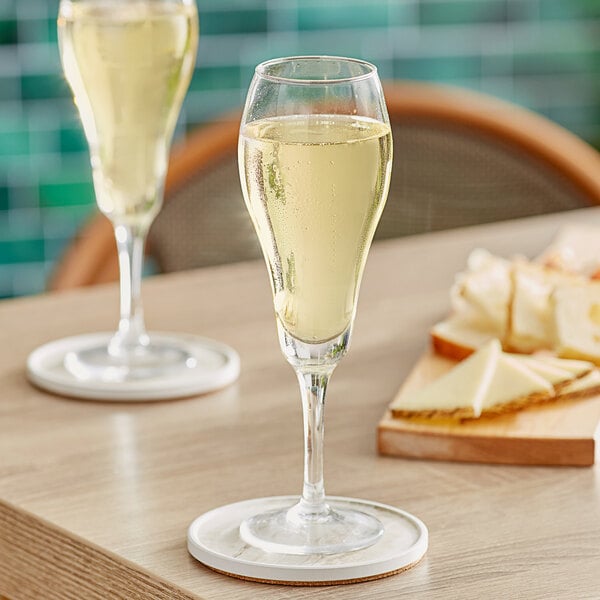
History and Design
Following the success of the champagne flute, tulip champagne glasses became popular around the world in the 1930s. Named after the flower, these glasses feature a long, narrow stem and an elongated oval shape with a broader, rounder middle and a narrow top.
Characteristics
•Long, narrow stem
•Elongated oval shape
•Broader, rounder middle
•Narrow rim
•Teardrop silhouette
Effect on Champagne
The tulip’s signature teardrop shape traps aromas inside the bowl and funnels them toward the drinker’s nose. The wider bowl provides more room for bubbles to aerate and dance around, but the narrow rim prevents them from easily escaping. Many champagne experts consider the tulip to be the perfect compromise between the coupe and flute designs, offering the best of both worlds: aroma development and bubble retention.
Proper Holding Technique
Similar to other stemmed champagne glasses, it’s best to hold the tulip glass at the top of the stem or by the base to avoid warming the wine with your hands.
Best Uses
•Contemporary dining settings
•Casual social occasions
•When both aroma development and bubble retention are desired
•For champagne connoisseurs who want to experience the full bouquet
Comparison Between Glass Types
Coupe vs. Flute

•Shape: Coupe is wider and shorter; flute is taller and slimmer
•Capacity: Coupe holds more champagne per glass
•Bubble Retention: Flute retains bubbles longer; coupe loses fizz more quickly
•Aroma Development: Coupe allows more oxygen interaction and aroma development
•Aesthetic: Coupe has a vintage, theatrical appeal; flute offers modern elegance
Flute vs. Tulip
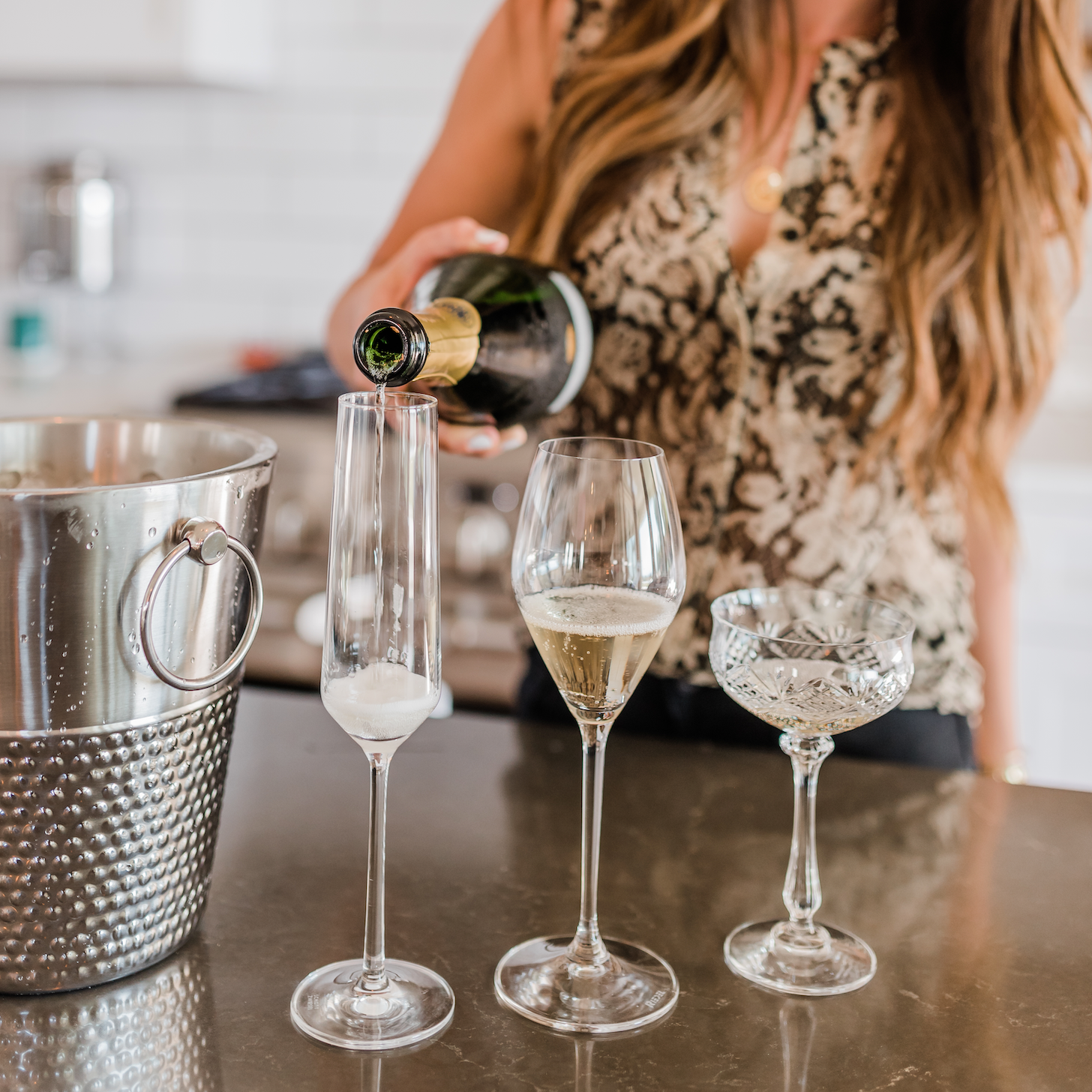
•Shape: Flute has straighter sides; tulip has a broader middle that curves inward at the rim
•Bubble Retention: Both retain carbonation well, but in different ways
•Aroma Concentration: Tulip’s design better concentrates aromas while still maintaining fizz
•Versatility: Tulip is considered more versatile for different champagne styles
Impact on Drinking Experience
The type of champagne glass significantly impacts the overall drinking experience:
1.Bubble Retention: The narrower the opening, the longer the champagne will maintain its effervescence. Flutes and tulips excel in this area, while coupes allow bubbles to dissipate more quickly.
2.Aroma Development: Wider bowls, like those found in coupes and tulips, allow more oxygen to interact with the wine, developing the aromas more fully. The tulip’s narrow rim then concentrates these aromas toward the nose.
3.Temperature Maintenance: Stemmed glasses help maintain cooler temperatures longer, as they prevent the heat from your hands from warming the champagne. The amount of surface area also affects temperature; narrower glasses like flutes keep champagne cooler longer.
4.Visual Appeal: Each glass type offers a different visual experience. Coupes showcase the dancing bubbles across a wide surface, flutes display the upward stream of bubbles in a column, and tulips combine both effects.
5.Material Impact: Crystal outperforms regular glass in terms of transparency and brightness, enhancing the visual appreciation of the champagne’s color. Crystal can also be produced extremely thin while remaining durable, which means less material interacts with your mouth, potentially allowing for better flavor appreciation.
Other Considerations
Can You Drink Champagne in a Regular Wine Glass?
Yes, champagne can be enjoyed in a regular wine glass, particularly a white wine glass. Some champagne experts actually prefer this approach for certain types of champagne, as the wider bowl allows the aromas to develop more fully. However, the bubbles will dissipate more quickly than in a flute or tulip glass.
Material Considerations
Champagne glasses are typically made from either glass or crystal:
•Glass: More affordable, dishwasher-safe, and durable
•Crystal: Offers better clarity, can be made thinner, and may enhance the visual and taste experience
Popular Brands
Some well-regarded champagne glass brands include:
•LSA (offering collections like Moya, Wine Collection, Polka, Borough, and Savoy)
•Riedel (known for Vinum, Performance, and Extreme Rose collections)
•Waterford (featuring Lismore Essence and Elegance Crystal collections)
Choosing the Right Champagne Glass
The ideal champagne glass depends on several factors:
1.Occasion: For formal events and toasts, flutes are traditional. For vintage-themed parties, coupes add theatrical flair. For wine-focused gatherings where appreciation of aroma is important, tulips are ideal.
2.Champagne Type: Different champagnes may benefit from different glass shapes. Vintage and complex champagnes often show better in tulip glasses or even white wine glasses, while simple, fresh champagnes work well in flutes.
3.Drinking Experience Priority: If maintaining bubbles is your priority, choose flutes. If you want to experience the full aroma profile, select tulips. If visual appeal and tradition are most important, go with coupes.
4.Practical Considerations: Consider storage space, durability needs, and whether dishwasher-safe options are important for your lifestyle.
DM Glassware Customization Services: Adding Personality to Your Champagne Glasses
After understanding the characteristics and benefits of different champagne glass types, you might want to add personalized elements for special occasions or business needs.
DM Glassware offers comprehensive customization services that can transform ordinary champagne glasses into unique mementos or brand promotion tools.
Customization Options Offered by DM Glassware
DM Glassware provides custom glassware for various occasions, with main products including machine-made glassware and glass cups.
We offer a wide range of customization services, including:
1.Logo Printing: Add your company logo, event name, or personal design to champagne glasses, creating unique mementos for corporate events, weddings, or special celebrations.

2.Engraving Services: Create permanent designs on glass surfaces through fine engraving techniques, suitable for higher-end gifts or keepsakes.

3.Custom Painting: Add color and artistic elements to your champagne glasses, creating visually striking custom designs.
Applications for Custom Champagne Glasses
1.Corporate Events: Custom champagne glasses with company logos can elevate corporate celebrations, annual meetings, or client appreciation events.
2.Weddings and Celebrations: Personalized champagne glasses can serve as special mementos for weddings or anniversaries, engraved with the couple’s names and date.
3.Promotions and Branding: Hotels, restaurants, or event planning companies can use champagne glasses with brand identifiers to enhance brand awareness.
4.Personal Collections: Add unique custom champagne glasses to your home bar or collection, showcasing your personal style.
The Customization Process
DM Glassware’s customization process is straightforward:
1.Select Base Glass Type: Choose from coupe, flute, or tulip styles that best suit your needs.
2.Submit Design: Provide the design or logo you want printed, engraved, or painted.
3.Sample Confirmation: Confirm samples before mass production to ensure the design effect meets expectations.
4.Production and Delivery: Complete the customization process and deliver the finished products.
Through DM Glassware’s customization services, you can combine your understanding of champagne glass types with personalized elements to create glassware that is both practical and unique, adding a memorable touch to your special occasions.
Conclusion
Choosing a champagne glass is more than just an aesthetic decision—it fundamentally affects how you experience the champagne’s flavor, aroma, and effervescence. Whether you prefer the vintage charm of the coupe, the elegant simplicity of the flute, or the balanced design of the tulip, understanding the characteristics and benefits of each glass type allows you to make an informed choice that enhances your champagne enjoyment.
Each glass has its place in the champagne experience, and many enthusiasts keep a variety on hand to match different occasions, champagne styles, and personal preferences. By selecting the right glass for your specific needs and considering the customization options offered by DM Glassware, you can elevate your champagne experience from ordinary to extraordinary.
References
1.The Champagne Company. (2024, July 18). A Guide to Different Types of Champagne Glasses. https://thechampagnecompany.com/blog/types-of-champagne-glasses.html
2.Champagne Club. (2024, January 29). Different Types of Champagne Glasses: Your Comprehensive Glassware Guide. https://www.champagneclub.com/different-types-of-champagne-glasses-a-full-guide/
3.Waterford. (n.d.). Guide to Different Types of Champagne Glasses. https://www.waterford.com/en-us/discover-waterford/journal/inspiration/champagne-glass-guide
4.DM Glassware. (2024). Custom High-quality Drinking Glasses. https://dmglassware.com/drinking-glasses/

